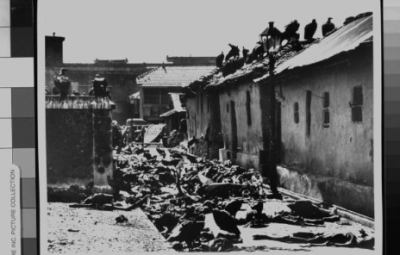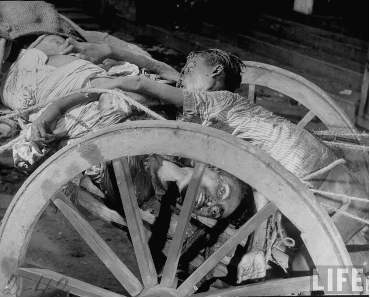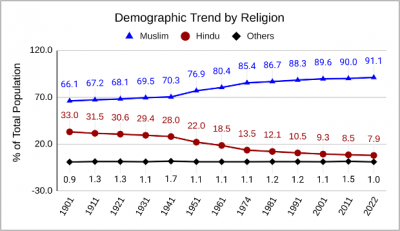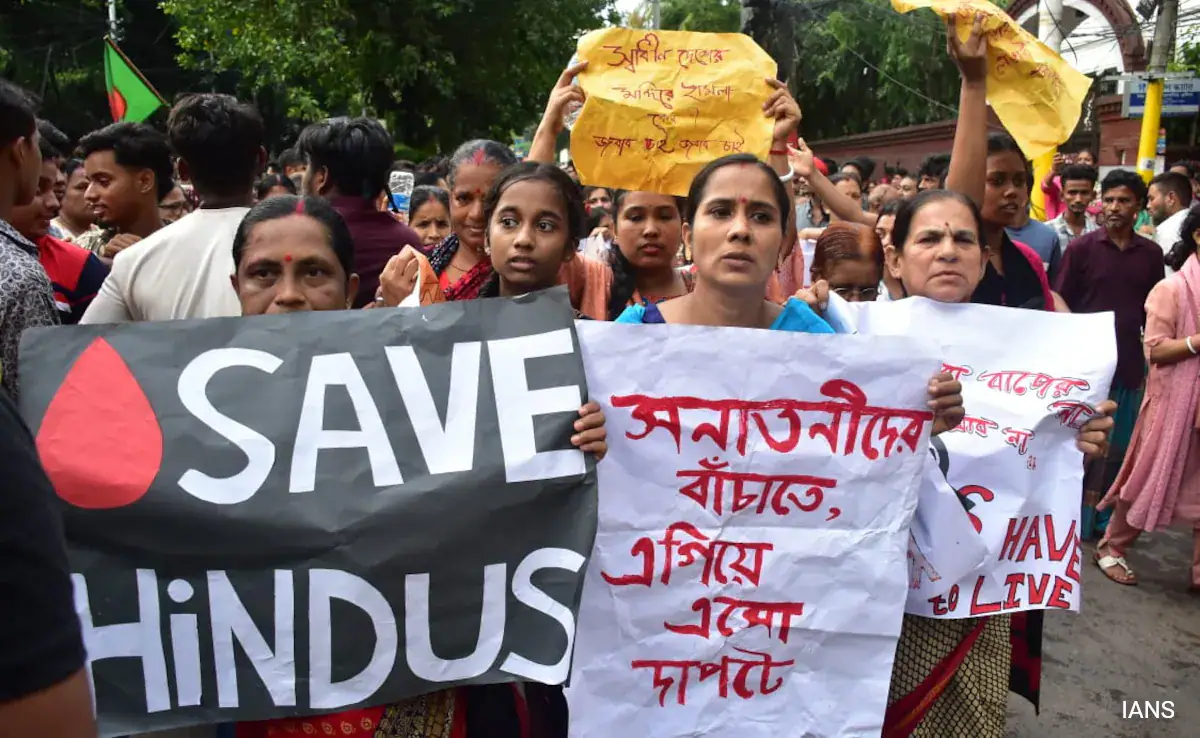Forgotten Neighbors: The Eighty-Year Ordeal of Hindus in Bangladesh
Picture Courtesy: NDTV
This past year saw a “regime change” in Bangladesh that some have argued was engineered and orchestrated by a combination of international forces. Whatever the deep state machinations might have been, and surely there is evidence for it in the one-page advertisement taken out by former President Barack Obama in The Washington Post on September 4, 2024, and signed by 198 “global leaders,” the immediate and troublesome outcome was the targeting of Hindus in the country.
In a new film/docudrama, titled “The Bengal Files,” filmmaker Vivek Agnihotri offers viewers a gory view of what transpired in East Bengal in 1946/47 and the violence that India and the world have chosen to forget. That forgetting can shine a light on what transpired in 2024.
While there are a few books and some efforts by Hindu human rights organizations to document and report the violence against Hindus, little has come of it. What should be done now? For one, there is no comprehensive documentation of the terrors that the Hindu population has faced in Bengal over the past few centuries. Some of the documentations fail to connect the dots and identify the basic factors and the major actors behind the attempts at eliminating the Hindu population from the Bengal region.
The latest in the series of incidents/events/campaigns targeting Hindus happened in July 2024. What began as a student-led protest against a government jobs quota swelled into a nationwide “revolt,” allegedly led by students. Crowds toppled monuments, political leaders fled, and mobs roamed the streets. Amid this upheaval, Hindu homes and temples once again became soft and easy targets. Families cowered behind locked doors; idols were smashed in temples; women were dragged from their homes, beaten up, raped, or killed; businesses burned down; Hindu men and priests were beaten up and bludgeoned. This should not have come as a surprise to Bangladesh’s Hindu minority, for they have borne the brunt of such Islam-inspired attacks carried out by Muslims for a long while.
In a report compiled by the Indic Center for Human Rights, the authors contend that this wasn’t an isolated spasm of chaos and violence. For Hindus in Bangladesh, persecution has been part of their threatened existence—steady, unrelenting, and often ignored by the outside world—not just from the creation of the new country in 1971, and when it was partitioned from India in 1947, but from the time of Islamic invasions centuries ago. In terms of recent history, however, from the bloody massacres of 1946 to the mass rapes of 1971, and from the pogroms of the 1990s to the riots of 2024, one pattern has remained unchanged: political storms in Bangladesh almost always unleash violence on Hindus.
Today, the Hindu population has dwindled from nearly one-third of East Bengal in 1947 to less than 8 percent in 2022. Behind that statistic lies a story of killings, rapes, forced conversions, land grabs, and mass migration. It is a story of a community slowly erased from its ancestral homeland.
A Long Shadow of Violence
The roots of this tragedy stretch deep into the region’s past. When India was partitioned in 1947, Bengal was split into two—West Bengal went to India, while East Bengal became part of Pakistan. Hindus suddenly found themselves trapped as a vulnerable minority in a state founded on Islamic identity.
But even before Partition, the warning signs were clear. In August 1946, the All-India Muslim League declared “Direct Action Day” to demand a separate Muslim homeland. Within 72 hours, more than 6,000 Hindus were butchered in Kolkata, then Calcutta. Women were raped, temples desecrated, neighborhoods burned. Later that year, in Noakhali, mobs killed thousands more, forcing survivors to eat beef and recite Islamic prayers before “converting” them at gunpoint.
These atrocities set the tone for decades to come. Hindus were marked as expendable, their existence tolerated only on sufferance. One of the remarkable findings retold in “The Bengal Files” is that the “Bangabandhu,” Sheikh Mujibur Rehman, voted the “Greatest Bengali of All Time” in a 2004 BBC opinion poll, was an enthusiastic participant in the “Direct Action Day” assault on Hindus.
___________________________________________________________________
A glimpse of the gruesome killing during Direct Action Day captured by the American photographer Margaret Bourke-White:

(Source: LIFE photo archive)

(Source: LIFE photo archive)
Partition and Its Aftermath
When India was split into two by the British, as many as 12 million Hindus lived in East Pakistan. They faced discrimination from the start. Laws branded them “enemies,” their lands seized under the notorious Enemy Property Act. Millions fled to India in waves, carrying nothing but the clothes on their backs.
Military dictatorships in the 1960s brought fresh horrors. Entire villages were torched. In Khulna and Dhaka, mobs massacred Hindu mill workers—30,000 in a single campaign. By the end of the decade, more than 1.2 million Hindu households had been stripped of their property and forced out.
Then came 1971.
Operation Searchlight: Bangladesh’s Bloody Birth
On March 25, 1971, the Pakistan Army launched Operation Searchlight to crush Bengali demands for independence. What followed was one of the most ruthless genocides of the twentieth century.
Soldiers, aided by local collaborators, went village to village asking: Are there Hindus here? If the answer was yes, the houses were burned, the men shot, the women dragged away. Male victims were ordered to prove their faith by reciting Muslim prayers or by showing circumcision scars. Failure meant death.
By December, when the war ended, an estimated three million Hindus lay dead. More than 400,000 women—many of them Hindu—had been raped, often in front of their families. Nearly ten million refugees, overwhelmingly Hindu, poured into India. Senator Edward Kennedy, visiting refugee camps, reported that Hindus were systematically “slaughtered and painted with yellow patches marked ‘H.’”
Yet, despite the staggering scale, the genocide has largely been erased from international memory. Few perpetrators were punished. Survivors were left to rebuild amid ruins. The “International Crimes Tribunal (ICT)” was set up in 2009 to investigate the human rights abuses carried out during the “Bangladesh Liberation War”. The fact-finding committee identified 1,600 suspects, but the main perpetrators being Pakistan’s soldiers, have gone unpunished. Moreover, international institutions and activists have thrown spanners in the work of the ICT, and further violent events in the country have led to the release of those who were arrested for their role in the 1971 massacres.
The Cycle Continues
Despite India’s efforts and the Indian military’s help in getting East Pakistan out of the clutches of West Pakistan, independence in 1971 did not bring safety to Hindus. In 1988, Bangladesh amended its constitution to declare Islam the state religion. Attacks on Hindus surged. In 1989, riots linked to the Ram temple movement in India left hundreds dead and forced thousands more Hindus across the border.
The demolition of the Babri Masjid in India in 1992 triggered another wave of pogroms. Hindu homes and temples across Bangladesh were torched; women were raped; whole villages were burned.
The 2001 election violence was just as brutal. Human rights groups documented more than 15,000 incidents of killings, rapes, torture, and land grabs against minorities in the months following the vote. One of the most chilling attacks came in 2003, when Islamists set fire to a Hindu family’s home in Banskhali, killing eleven members alive inside.
The pattern has continued into the 21st century. In 2021, mobs attacked Hindu neighborhoods after rumors of Quran desecration at a Puja pandal. In a single town, Hajiganj, at least 600 women and girls were sexually assaulted.
And then came the uprisings of 2024–25, when over 2,000 incidents of anti-Hindu violence were recorded across 52 districts.
The Human Cost
Numbers only tell part of the story, but they are staggering. Between 1946 and 2025:
- 3 to 4 million Hindus have been killed.
- More than 400,000 women and girls have been raped.
- 6 million acres of land have been seized, displacing 1.2 million families.
- Over 10 million Hindus have fled to India, creating one of the largest cases of ethnic cleansing in South Asia.
- The Hindu share of Bangladesh’s population has plummeted from 28% in 1941 to under 8% today.
But behind every figure is a family torn apart. Survivors speak of horror with quiet resignation.
One woman recalled how her husband was hacked to death before her eyes. She was then forced to eat beef—a profound violation of her faith—and “married” to one of the killers. “Those women had a dead look,” wrote a British relief worker in 1946. “It was not despair, nothing so active as that. It was blackness.”
In 2001, twelve-year-old Purnima Rani was gang raped by men she knew—neighbors who had once greeted her on the street. She survived, but thousands like her did not.

Bangladesh’s demographic trend since 1901 as % of the total population.
Why the Violence Never Ends
Every wave of violence has its trigger—Partition, a cyclone, an Indian court ruling, a student protest. But the victims remain the same.
Researchers argue that the attacks are not random outbursts but part of a pattern of ethnic cleansing. Hindus are seen as outsiders in a nation where politics is deeply entwined with religious identity. Each crisis becomes an opportunity for extremists to remind Hindus of their precarious place.
Laws like the Vested Property Act (VPA) and the Enemy Property Act (EPA), which legalized the seizure of Hindu lands, institutionalized this dispossession. To this day, Hindu families fight endless legal battles to reclaim ancestral property, often in vain.
The World’s Silence
Perhaps most shocking is not that the violence happens, but that it is met with indifference. International media cover Bangladesh’s elections, its garment industry, its climate challenges—but rarely the slow-motion erasure of its Hindu minority. The United Nations Human Rights Office of the High Commissioner published a 115-page report titled “Human Rights Violations and Abuses related to the Protests of July and August 2024 in Bangladesh,” in February 2025. One paragraph, on p.56, is all that is included on the attacks on “members of distinct religious and indigenous groups”. That the UN has been hijacked by a variety of countries and religious conglomerations is now common knowledge. That the 115-page report thus whitewashes the violence targeting Hindus should therefore come as no surprise.
Human rights organizations issue occasional reports, but governments have been reluctant to act. Strategic interests—India’s regional security, America’s counterterrorism cooperation, China’s trade ties—often eclipse minority rights.
What’s at Stake
If current trends continue, Hindus could virtually vanish from Bangladesh within fifty years. That would mean not just the loss of a community but the erasure of centuries of cultural heritage—temples, festivals, traditions, and the memory of coexistence that once defined Bengal.
It would also set a dangerous precedent: that systematic persecution, carried out quietly over decades, can succeed without the world lifting a finger.
The history of Hindus in Bangladesh is not merely a South Asian story. It is a human story, one that tests our willingness to confront injustice even when it is inconvenient.
For Bangladeshis who believe in pluralism, for Indians who see their neighbors suffer, for international bodies that claim to defend human rights, the time for polite silence is over.
Survivors have carried their scars for too long. From the widows of Noakhali to the refugees of 1971, from the families in Banskhali to the frightened children of Hajiganj, their voices echo the same plea: remember us, protect us, do not let us disappear.
History will judge whether we listened.
Hindus around the world must ask themselves if they want their children and grandchildren to be easy prey, literally waiting for somebody asking them to pull down their pants to decide if they should live or die (as has been happening repeatedly in Bangladesh and other places, with the latest incident in Pahalgam, India, on April 22, 2025). Is it OK to have Hindu women and girls raped in front of their family members, forced to marry the killers of their family members, and be forcefully converted to Islam? What can we do to ensure that Bangladeshi Hindus deserve a life of dignity and peace?
***
Satya Pradhan is a technology professional in California, USA, with research interests in Vedanta, Hinduism, and Hinduphobia.
Ramesh Rao is a professor of communication studies at Columbus State University in Columbus, GA, USA, and editor, India Facts.

